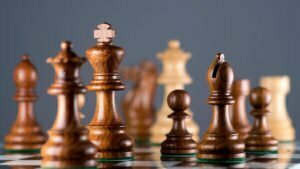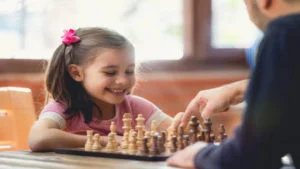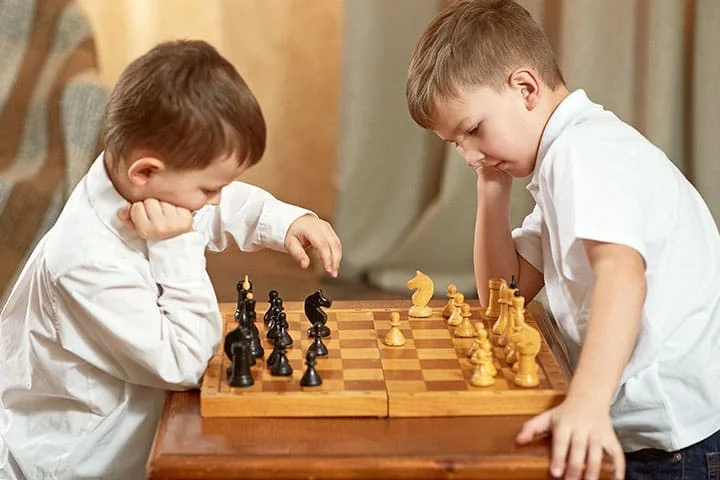Chess is a game of abstract strategy with no concealed information. It is played on a square chessboard with 64 squares laid out in an eight-by-eight grid. The game is between two players and the winner is decided when a checkmate occurs. Below, we have a detailed guide on the various chess pieces as well as how they work.
Also, check other articles on:
Number of Pieces in Chess

In chess, each player begins with 16 pieces, which includes eight pawns, two bishops, two knights, two rooks, one queen, and one king. Thus, there are 6 unique chess pieces. Also, each piece has its own set of abilities and to become a great chess player, you must first grasp these powers and how to apply them to win the game.
What are the six chess pieces and what do they do?
Pawn
The pawn is the most neglected and the smallest piece on the board in most chess sets. However, each player begins a chess game by placing eight pawns in front of the other eight chess pieces.
How does a pawn move in chess?
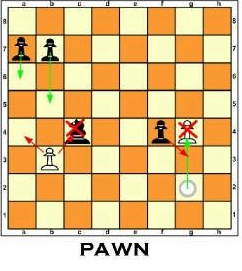
Compared to other pieces, the pawn has the fewest choices for movement. However, despite this, pawns may move in both basic and sophisticated ways.
A pawn can only travel forward one square until it reaches the other side of the board, but, there are two exceptions to this rule. Firstly, pawns can only move two squares forward on their first move. Secondly, when capturing an opponent’s chess piece, pawns can travel diagonally forward.
Another rule to note is that when a pawn reaches the other side of the chessboard, the player may trade it in for any other chess piece except for another king.
Pawn names
Now that you know how pawns move, let us look at the different names for each pawn as all pawns are not created equal. The two outside pawns are known as Rook Pawns, whereas the pawns in front of the King and Queen at the start of a game are known as King Pawn and Queen Pawn, respectively. Furthermore, the pawns on each side of the king and queen are given the names Bishop Pawn and Knight Pawn.
Pawns on the Queen’s side of the board are referred to as the Queenside, whereas pawns on the King’s side of the board are referred to as the Kingside. At the start of the game, for example, the pawn on the far left side is called the Queen Rook Pawn. Similarly, the pawn second from the right would be referred to as the KN-pawn (King Knight Pawn).
The counter pawn is your opponent’s pawn right across the board from your own piece. Each pawn on your board has its own counter pawn at the start of the game.
Pawn terms
At the start of the game, all pawns are regarded as unfree or incapable of reaching the opposite side of the board due to their counter pawns. However, when a pawn’s counter pawn is taken, the pawn is regarded as half-free.
Each piece on the board is also surrounded by opposing pawns known as sentries. Sentries are the opponent’s pawn chess pieces that sit directly across from it but are separated by one square to the left as well as right. Your opponent may employ these pawns to capture your pawn. In addition, they also make it harder for your pawn to cross the board.
Each of your pawn chess pieces has an assistant. Also, These are the pawn pieces next to it that can be utilised to assist the pawn chess piece to cross the board. A pawn piece is referred to as a candidate when it is attempting to reach the other side of the board. In most circumstances, your candidate piece would advance first, followed by its assistant pieces, to ensure its safety.
Therefore, After capturing the sentries of a pawn piece, the pawn is now regarded free. This implies it is no longer blocked from reaching the other side of the board by opposing pawns.
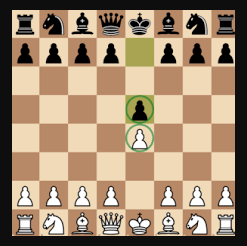
One more term you must know about is a ram. A ram occurs when two pawn pieces are impeding each other’s movement across the board. When assistant pawns are engaged, a ram can be broken, allowing the pawn chess piece to advance. You must remember to avoid rams when attacking the opposing team as it eliminates your ability to employ the pawn in the attack.
How to improve pawn play?
Pawns may be incredibly important tools while playing chess. Therefore, understanding how to employ pawns in chess at a deeper level is critical to becoming a great chess player. Thus, here are some excellent books for understanding pawn play in chess:
The Rook
The piece, which resembles a castle tower in conventional sets is called the rook. Each player has two rook pieces that are placed on either end of the chessboard.
How does a rook move in chess?

The rooks are the chess pieces with the simplest movement on the board. At any point, the rook piece can move forward, backward, left, as well as right. The rook piece can travel 1 to 7 squares in any direction as long as it is not blocked by another piece.
Castling
The only piece on the board that may engage in a “Castling” move with the King piece is the rook. This is a move in which the King and Rook pieces collaborate, allowing the player to move two pieces at the same time. Look at the video below to learn to Castle.
The Knight
In a chess set, the knight chess piece provides the most opportunity for variation as well as individuality, and it is frequently the piece with the most detail.
How does a knight move in chess?
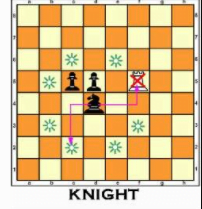
The Knight chess piece moves in an enigmatic manner. Unlike rooks, bishops, and queens, it has a restricted amount of squares it may travel over. The piece only moves in the shape of an uppercase “L.”
The Knight piece may move two squares ahead, backward, left or right, and then one square in each perpendicular direction. It can only go to one of the board’s eight possible spots, provided that it is not occupied by another piece of the same colour. In addition, an interesting feature of the knight is that it can jump over any other piece to get to its destination.
Fundamental tactics
Because of their unusual mobility, knight pieces may frequently conceal flaws that other pieces leave exposed. Thus, they are best used towards the centre of the board. In addition, they are frequently one of the first pieces to get there. The Knight also has the unusual ability to attack another piece while avoiding being hit by the same piece.
The Bishop
The Bishop chess piece is perhaps the most overlooked of all chess pieces. From the perspective of a beginner, the piece cannot do much to aid your game because each piece can only cover half of the board at a time and is highly vulnerable to attacks from the front.
How does a bishop move in chess?

The bishop is only able to move diagonally. Each player begins with two bishop pieces, each of which is assigned to a different colour square.
The bishop can travel diagonally in any direction as long as it is not impeded by another piece. You can cover the entire board with both pieces, but one piece can only cover half of the board. Furthermore, it can only move over the squares which are the same colour as the one the bishop started the game on.
An important fact to note is that the bishop piece is unable to go past any piece that is in its way. Additionally, it can take any other piece on the board that moves within its range.
Fundamental tactics
Bishops are typically seen as stronger pieces after the game. However, during the early stages of the game, the pawns make it impossible to employ the bishop piece. Although the bishop is regarded great for protecting a castled King, experts agree that sacrificing a bishop is preferable, as it allows the rook to move.
The Queen
The queen is considered to be the most deadly and flexible piece on the board. Unless you are a chess master, losing your queen piece might easily be the last blow before succumbing to your opponent.
How does a queen move in chess?
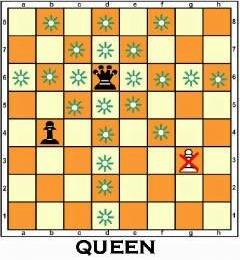
Each player begins with one queen piece. The queen can travel in any direction, either straight or diagonally. Because the queen cannot “jump” over any piece on the board, its mobility is limited to any direction of vacant squares. Furthermore, any of your opponent’s pieces on the board can be captured by the queen.
Fundamental tactics
Because of its capacity to move, most players prefer to keep their queen guarded. It is an extremely valuable piece in any chess game and is frequently used in endgame strategy. The queen may be employed in several defensive strategies and can be utilized to guard the King regardless of where the King is on the board, as long as the queen is nearby.
Because the queen may not be able to immediately strike a knight piece that is assaulting the queen, players must be careful of their opponent’s knight pieces. Advanced players are more likely to sacrifice their queen to win a game, but this is extremely unusual. The video below shows the tactics you can use to play the queen to win the game.
The King
The last piece to discuss is the king. This is a game-winning piece. The game ends when your king is checkmated, and your opponent wins regardless of the score.
The King is the most important chess piece to safeguard as it cannot be replaced. Many skilled players, however, may find themselves using their king to gain an edge over an opponent, which is something that inexperienced chess players are particularly wary of doing.
How does a king move in chess?

The mobility of the king chess piece is fairly restricted. They cannot move as swiftly as most other pieces across the chessboard, but they are simpler to confine from an opponent’s standpoint.
The king piece can move one space in any direction. However, it cannot move onto a tile occupied by a piece from its own team. Furthermore, the king piece is not allowed to move to any square that places them in a check position.
Fundamental tactics
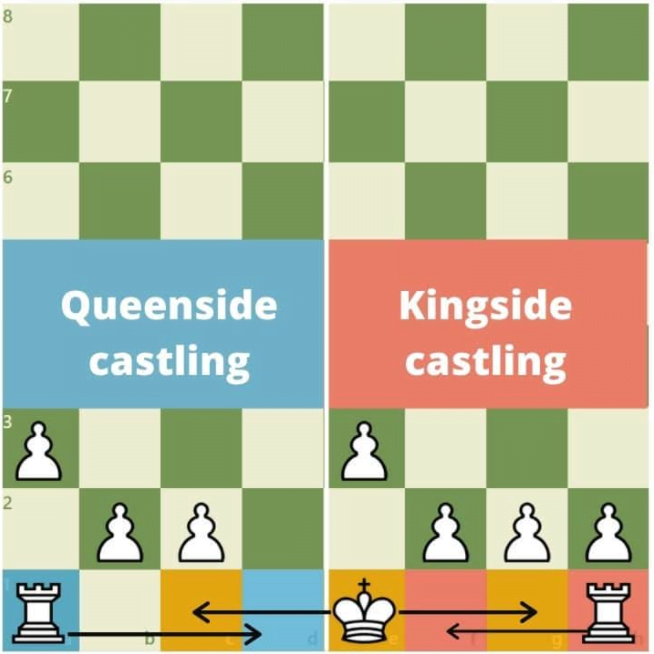
Experienced players employ their king pieces to assist in trapping as well as capturing opponent pieces. However, most players aim to keep their king piece in one of their two corners, where there are fewer possible assault directions. The player can do this by castling with a rook.
How much is each chess piece worth?
A pawn is worth one point, a bishop and knight are worth three, a rook is worth five, and a queen is worth nine. The only piece that does not have a point value is the king.
How must you arrange the chess pieces on the game board?
First, begin by arranging the pawns in the second rank. Putting all of your pawns on first helps to remove the pile of pieces near to the board, making it easier for the rest of your pieces to go on. Then, place your rooks in the corners of the board. Arrange your knights alongside your rooks. The bishop is sandwiched between the regal king or queen and the knight. Then, in the centre, place the king and the queen. An easy way to remember the position of the pieces is using the pneumonic- “queen wants to match her dress”. Thus, the white queen is placed on the light square, and the black queen is placed on the dark square. Finally, place your king on the remaining square.
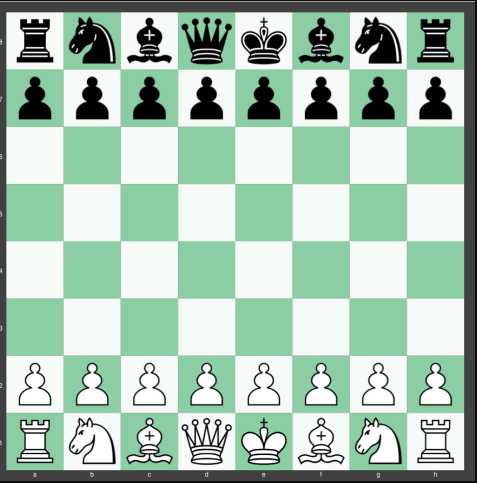
Summary
Each player plays chess with 6 unique pieces. Their names and how they move is given below.
| Name of piece | How they move | Points awarded |
| Kings | Kings can move one tile in any direction as long as it is not assaulted by an opponent piece. In addition, kings can perform a unique move called castling. | . |
| Queens | Queens can move any number of squares diagonally, horizontally, or vertically. However, they can’t jump over the pieces. | 9 |
| Rooks | Rooks can move any number of spaces horizontally or vertically. However, they can’t jump over the pieces. When the king castles, the rooks move. | 5 |
| Bishops | Bishops can move any number of squares diagonally., but, they can’t jump over the pieces. | 3 |
| Knights | Knights move in an ‘L’ shape: two squares horizontally or vertically, then one square horizontally or vertically. They are the only component that can leap over other pieces. | 3 |
| Pawns | During the first move, a pawn may move forward one or two spaces. On all subsequent turns, they may only move one space forward. Pawns can only capture pieces while moving forward and diagonally, either to the left or the right. | 1 |
FAQs
What is the most powerful chess piece?
The queen is the most powerful piece on the chessboard and one of the most famous components in any game. It is the most valuable piece in the game of chess in terms of raw power, apart from the king. The queen moves in a direction that resembles the combined actions of the rook and the bishop.
What are the symbols used in chess?
Given below are the various symbols used in chess.
- W means victory, earning one point.
- L stands for loss and is worth 0 points.
- D stands for a draw, and it is worth 0.5 points.
- B is 1 point for a full-point bye that is given to the left-over player when there are an odd number of players in a tournament round.
- H is worth 0.5 points and refers to the half-point bye that is given to the players who won’t be able to make it to certain rounds of a tournament.
- X refers to the 1 point for a win through forfeit.
- F means a forfeit loss, earning 0 points. It usually results in automatic withdrawal from the rest of the tournament.
- U is an unplayed game with a value of 0 points. This might also occur if a player wishes to skip games without withdrawing from the competition. However, the player will not receive any points for the missed games.
Is a rook worth more than a knight and a bishop?
A rook is traditionally valued at 5 points, whereas a knight and bishop are worth 3 points. Therefore, a rook is worth more than a knight as well as a bishop.
In chess, can a knight capture a queen?
In chess, a knight can capture a queen. Any chess piece can capture the queen.
Where did the names of the chess pieces come from?
The first chess pieces were named shah (king), fil (bishop), rukh (rook), wazir (counsellor), asp (knight), and piyade (pawn) in India, the birthplace of chess. Shah, farzin, rukh, pil, asp, and piyada were among the first Persian names. However, they were called shah, firzan, fil, faras, rukhkh, and baidaq in Arabic. Western countries attempted to translate the oldest names as accurately as possible.
The table given below contains all the earlier names of the chess pieces.
| Original Name | Modern Chess Pieces | Original Movement |
| Horse | Knight | The same as in the present (L-shaped) |
| Chariot | Rook | The same as in the present (vertical and horizontal, any amount of squares) |
| Infantry/foot soldier | Pawn | Infantry/foot soldier |
| Elephant | Bishop | Persia: just two squares diagonally. Could leap over obstacles. |
| India: two squares placed side by side or front as well as back. Could jump over a chess piece between | ||
| Southeast Asia as well as East Asia: Move one space diagonally or forward one square. Just like an elephant’s four legs and trunk | ||
| Adviser | Queen | Move one space diagonally. |
| King | King | The same as in the present(one space in any direction) |
Which chess piece cannot be captured?
Each player is given one chess piece known as the king. The game’s ultimate goal is to capture the opposing monarch. Having said that, the monarch will never be apprehended. When either side’s king is trapped to the point where it cannot move without being captured, the situation is referred to as “checkmate” or the abbreviated term “mate.”
Which chess piece cannot travel backwards?
A pawn has numerous specific moves, but one limitation is that it cannot go backwards. Another distinguishing aspect of the pawn is that, unlike other pieces that capture on the square on which they land, a pawn moves one square ahead but captures diagonally.
What chess piececano jump?
The knight is the only chess piece that has the ability to “jump over” other pieces, whether they are black or white.
Chess was invented in which country?
Chess was created in the 8th century in India. The name was modified over the ages by the Arabs, Persians, and, finally, mediaeval Europeans, who changed the names and looks of the pieces to mimic the English court.
What do chess pieces represent?
In chess, each chess piece represents a different character or thing. The King and Queen are considered royalty, while the Bishop represents the church. Pawns represent the infantry and the Knight is a high-ranking fighter or Equine representative. The Castle Walls of the land is represented by the Rook.
How many moves does it take a player to checkmate his opponent’s king?
Both the USCF and FIDE rules state that each player has 50 moves to either mate the King or have something of theirs captured. If no other pieces can be moved, the player must move a pawn. When they move a pawn or capture a piece the count begins again.
What effect does chess have on your brain?
Chess, according to the researchers, tests memory, math, visual-spatial skills, and critical thinking ability. As a result, it may assist to minimise cognitive decline and delaying the consequences of dementia as you age.
Share with your friends
